HTML
--> --> -->The molecular dynamics (MD) method [18, 19] is a microscopic many body approach, which has been successful in materials science, chemical physics and biomolecules [20-22]. It has the advantage of being able to solve various problems without many assumptions. To study the microscopic dynamics of quark matter during the hadronization process dominated by non-perturbative QCD, methods of MD simulation have been applied in recent years [23-30]. Ref. [23] studied the hermalization process of a strongly interacting quark matter. Ref. [24] used quantum molecular dynamics to study the quark phase transition of a quark system at finite density. A relativistic molecular dynamics approach based on Nambu-Jona-Lasinio (NJL) Lagrangian [31] was applied in Ref. [25] to study the evolution of high energy heavy ion collisions. The NJL model, as a low energy approximation to the QCD theory, has been applied to study the properties of baryon-rich matter [32-34]. A quark molecular dynamics based on a non-relativistic approach was used to describe hadronization of an expanding quark gluon plasma in heavy ion collisions with particle creation taken into consideration in Refs. [26, 27]. Refs. [28, 29] analyzed the properties of quark matter at finite baryon densities and zero temperature by using a semi-classical constrained molecular dynamics approach.
In this paper, we study the hadronization process microscopically using a quark coalescence model in the framework of the semi-relativistic molecular dynamics method. In this model, quarks are treated as particles moving synchronously with relativistic velocities and interacting through a potential, which leads to hadronization of quarks. The implementation of the model is based on the work in [30] and a generalized form of the Cornell potential used in that paper. In Refs. [26, 27], the Cornell potential was also applied by using the classical molecular dynamics to yield colorless clusters. However, the details of implementation, such as the determination of the color factor, initial state, algorithm, criteria to end the evolution, hadron identification etc., are different from ours. Our study is preliminary and focuses on the effects of different parameters on the final state properties of hadrons by analyzing the variations of baryon-to-meson ratio, transverse momentum spectra, pseudorapidity distributions and forward-backward multiplicity correlations with different values of parameters.
This paper is organized as follows. In Section 2, the phenomenological potential and related dynamics are discussed. Its application to hadronization is described in Section 3 for quarks produced by PYTHIA in pp collisions. The obtained final state distributions and correlations are presented in Section 4. A discussion is given in the last section.
2.1.Interaction potential
In our study, a Cornell-like phenomenological potential [35-37] is employed with some free parameters. The Cornell potential has gained success in describing the properties of bound states, especially heavy quark mesons [37-40]. It is parametrized as a linear combination of the Coulomb and linear potentials. The Coulomb term, similar in behavior to the electromagnetic case, is responsible for the one-gluon exchange between two quarks, while the linear term dominates when the distance is large and thus gives rise to confinement. In this paper, quarks and antiquarks are treated as particles interacting through this kind of potential depending on their distance and color combination. The potential between a pair of quarks i and j separated by a distance${V_{ij}} = {\alpha _{ij}}\left(a{r_{ij}} - \frac{b}{{{r_{ij}}}}\right) + c,$ | (1) |
This paper regards a and b as adjustable parameters, which correspond to the string tension and phenomenological strong coupling constant, respectively. Note that the unit of b is GeV·fm, which needs to be converted to get the usual dimensionless coupling constant, e.g. b=0.1 GeV·fm
The value of the color factor
The sign of
The next step is the determination of relative strengths of
  | r | g | b |   |   |   |
| r | ?1 |   |   | 1 |   |   |
| g |   | ?1 |   |   | 1 |   |
| b |   |   | ?1 |   |   | 1 |
  | 1 |   |   | ?1 |   |   |
  |   | 1 |   |   | ?1 |   |
  |   |   | 1 |   |   | ?1 |
Table1.The color factor
The color factors deduced here are the same as those in Refs. [26, 27], which are obtained from the Lagrangian for one-gluon exchange in QCD interactions.
2
2.2.Dynamics
Since it is hard to describe the microscopic dynamics of a relativistic many body system in a relativistically consistent way [41, 42], in this paper we treat quarks and antiquarks as particles whose motion is driven by the forces they exert on each other. For a system consisting of quarks and antiquarks, the color charges of quarks (or antiquarks) are fixed as an approximation. Additionally, gluons are not considered as particles in the model, but are accounted for in the background field of the system.It should also be noted that the relativistic effects, such as retardation and chromomagnetism should be taken into account, since most quarks in our simulation are light quarks. However, because of many difficulties for a many-particle system, these are not included in our present work. Additionally, since the proper time of each particle in the system is different, the choice of the reference frame is also an issue. In our study, we only consider the time with respect to the laboratory frame (i.e. the center-of-mass frame of the pp collision), and assume that all quarks and antiquarks interact synchronously.
The motion of quarks and antiquarks in the system is influenced by their mutual interaction. From Eq. (1), one can get the force acting on quark i from quark j,
$\overrightarrow {{F_{ij}}} = - \nabla {V_{ij}} = - {\alpha _{ij}}\left(a\frac{{{{\vec r}_{ij}}}}{{|{{\vec r}_{ij}}|}} + b\frac{{{{\vec r}_{ij}}}}{{|{{\vec r}_{ij}}{|^3}}}\right),$ | (2) |
$\overrightarrow {{F_i}} = \sum\limits_{j \ne i} - {\alpha _{ij}}\left(a\frac{{{{\vec r}_{ij}}}}{{|{{\vec r}_{ij}}|}} + b\frac{{{{\vec r}_{ij}}}}{{|{{\vec r}_{ij}}{|^3}}}\right).$ | (3) |
$\left\{ \begin{split}&\displaystyle\frac{{{\rm d}{{\vec r}_i}}}{{{\rm d}t}} = {{\vec v}_i},\\&\displaystyle\frac{{{\rm d}{{\vec p}_i}}}{{{\rm d}t}} = {{\vec F}_i},\\&{{\vec v}_i} = \displaystyle\frac{{{{\vec p}_i}}}{{\sqrt {{m_i}^2 + {{\vec p}_i}^2} }}.\end{split} \right.$ | (4) |
$\begin{split}\vec p_{i,\parallel }' =& \gamma {({{\vec v}_{cm}})^2}[2{{\vec v}_{cm}}{E_i} - (1 + |{{\vec v}_{cm}}{|^2}){{\vec p}_{i,\parallel }}],\\E_i' =& \gamma {({{\vec v}_{cm}})^2}[(1 + |{{\vec v}_{cm}}{|^2}){E_i} - 2{{\vec v}_{cm}} \cdot {{\vec p}_{i,\parallel }}],\end{split}$ | (5) |
2
2.3.Integration method
The molecular dynamics simulation is performed by dividing the evolution time into a large number of time-steps. For each step, the force acting on each quark and the velocity of each quark are regarded as constant, and the position and momentum for the next time step can be calculated according to Eq. (4) by using some kind of integration method. In this way, as the time step advances, the position and momentum of each quark are updated, and the process can be repeated.Apparently, if the time-step is too large, the integration error is large, which leads to a relatively large error of dynamical properties and energy drift. On the other hand, if the time-step is too small, the cost of simulation will be too large, because updating the positions and momenta of all quarks for each step, and especially updating of forces, is time-consuming. For each step, to update the forces one needs to calculate the relative distances between all pairs of quarks, which is quite time-consuming if the number of quarks is large. Thus, the integration algorithm is vital to the accuracy and efficiency of simulation.
The velocity Verlet algorithm [18] is adopted in our model, considering that its accuracy is of the order of two (which is better than the usual Euler method), and it consumes less memory since each iterative step just needs the properties of the preceding step. In addition, it only requires to update the forces once for each step.
Suppose that the position, momentum, kinetic energy (rest energy included) of quark i at time t are
${\vec p_i}\left(t + \frac{1}{2}\delta t\right) = {\vec p_i}(t) + \frac{1}{2}\delta t{\vec F_i}(t),$ | (6) |
${\vec v_i}\left(t + \frac{1}{2}\delta t\right) = \frac{{{{\vec p}_i}\left(t + \displaystyle\frac{1}{2}\delta t\right)}}{{\sqrt {m_i^2 + {{\vec p}_i}{{\left(t + \displaystyle\frac{1}{2}\delta t\right)}^2}} }}.$ | (7) |
${\vec r_i}(t + \delta t) = {\vec r_i}(t) + {\vec v_i}\left(t + \frac{1}{2}\delta t\right)\delta t.$ | (8) |
${\vec p_i}(t + \delta t) = {\vec p_i}\left(t + \displaystyle\frac{1}{2}\delta t\right) + \displaystyle\frac{1}{2}\delta t{\vec F_i}(t + \delta t).$ | (9) |
2
3.1.Initial state
The initial state of quarks for a pp collision event is generated with the Monte Carlo generator PYTHIA [6, 7].PYTHIA is a simulation program that can be used to generate events in high-energy collisions between two incoming particles (e.g. pp, ep and
Hadrons produced directly by hadronization in PYTHIA (i.e. hadrons before decay) are input in our model as “parent hadrons” and their identities are coded according to the “The Monte Carlo particle numbering scheme” [44] used in PYTHIA. They are then decomposed into quarks and antiquarks, according to the flavors and spins of their valence quarks. A meson is converted into a quark and antiquark, while a baryon (or antibaryon) is first converted to a quark and diquark (or an antiquark and antidiquark), and the latter are then broken into quarks (or antiquarks). This decomposition is assumed to be isotropic in the rest frame of the parent hadron. The implementation of the decomposition is the same as in the diquark break-up method in Ref. [15]. This approach of obtaining the initial state is similar to that in AMPT with string melting [14]. The decomposition of “parent hadrons” is equivalent to keeping the evolution process at the parton level until all quarks and antiquarks are produced in the string fragmentation process in PYTHIA.
The sum of color charges of quarks from the same hadron is kept neutral, so that the whole system is also color neutral.
The masses of quarks and antiquarks during the decomposition are taken to be the current masses used in PYTHIA, e.g.
After all hadrons from PYTHIA are decomposed, the initial state consisting of quarks and antiquarks is generated. The properties, like masses, flavors, colors, momenta of all quarks and antiquarks are determined. However, the positions are not as the information about the coordinates of parent hadrons from PYTHIA is not available.
We set the initial positions of quarks and antiquarks using a simple method as follows. First, we assume that the parent hadrons are uniformly distributed in a circle lying in a transverse plane with a zero longitudinal coordinate. This is similar to the assumption used in Refs. [45, 46] that a pp collision can be approximately regarded as a disc as a result of the Lorentz contraction in the laboratory frame. The circle radius is set to 1 fm. We then define the formation time
${\vec r_i} = {\vec r_0} + {\vec v_h}{t_f} + {\vec v_q}t_f' = {\vec r_0} + \frac{{{{\vec p}_h}}}{{{E_h}}}{t_f} + \frac{{{{\vec p}_q}}}{{{E_q}}}t_f',$ | (10) |
Considering that quarks are formed at different stages during the pp collision process, we suppose that the formation time is a uniformly distributed random variable between 0 and the maximum formation time
In fact, according to the calculations using the initial geometry above, the value of the parameter c in the interaction potential in Eq. (1) is much smaller than a and b (about two orders of magnitude smaller), especially for events with large quark multiplicity.
Two kinds of quark masses are used in our model. In addition to the current masses used during the decomposition of parent hadrons mentioned above, quark masses during the evolution process are taken to be the constituent masses,
2
3.2.Evolution and hadronization
Because the speed of a quark with a large momentum (e.g. over 100 GeV) is usually very close to the speed of light, its momentum is nearly equal to its energy in magnitude. Thus the change of momentum does not have much effect on the change of its velocity and it is quite hard to separate quarks into color neutral clusters with speeds very near to 1. Therefore, in our study the dynamics of high energy quarks (decomposed from parent hadrons with energy larger than 50 GeV) are excluded from the evolution simulation.After removing high energy quarks, we use the Verlet method mentioned above to simulate the evolution of the quark system from a pp collision. The time-step is set to
After initialization, the system begins to evolve. The evolution of the system yields color neutral clusters of different sizes due to the interactions among quarks. A cluster is regarded as well separated from the others if the distance between the cluster and any other quark outside the cluster is larger than 2 fm. Once all quarks gather into clusters and the number and constituents of clusters do not change during 10 fm/c, the evolution process is considered to be finished. This treatment of hadronization is different from that in Refs. [26, 27], where a quark-antiquark pair (or three quarks or antiquarks) is regarded as a hadron when the interaction between the pair (or three quarks or antiquarks) and the rest of the system is weaker than a lower bound, and the formed hadron is removed from the system.
A small cluster containing one quark and one antiquark could be mapped as a meson, while a cluster composed of three quarks (or antiquarks) could be regarded as a baryon (or antibaryon). Occasionally, larger clusters containing more than three quarks may also form. These clusters can be regarded as multi-quark states, such as tetraquark and pentaquark. Since the relative motion among quarks in a multi-quark cluster is usually small (all with speed close to 1), if they happen to be close to each other, with short range interactions, it may be hard for them to be well separated into smaller clusters. Therefore, multi-quark states may survive for a long time during system evolution, and are allowed in our model. This is different from the requirement in Refs. [27, 30].
Figure 1 illustrates the quark spatial distributions for an event sample at three different points in time, with the evolution starting time set at t=0.
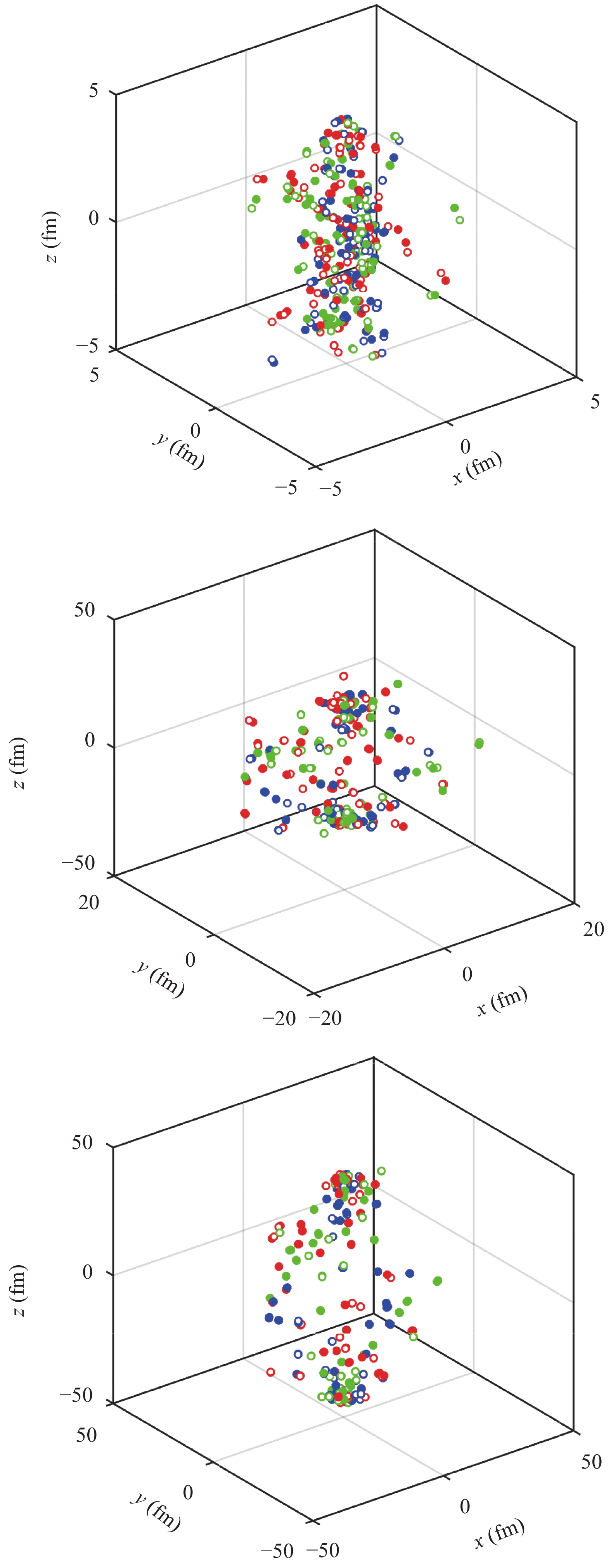 Figure1. (color online) Evolution of a system with 382 quarks and antiquarks input from PYTHIA at three different points in time: t=0 (top panel), t=20 fm/c (middle panel) and t=40 fm/c (bottom panel). The solid and open circles represent quarks and antiquarks, respectively, whose colors correspond to the circles.
Figure1. (color online) Evolution of a system with 382 quarks and antiquarks input from PYTHIA at three different points in time: t=0 (top panel), t=20 fm/c (middle panel) and t=40 fm/c (bottom panel). The solid and open circles represent quarks and antiquarks, respectively, whose colors correspond to the circles.2
3.3.Hadron identification
The mass$\begin{split}m_h^2 =& E_h^2 - \vec p_h^2\\ =& {\left(\displaystyle\sum\limits_i {\sqrt {m_i^2 + \vec p_i^2} + \displaystyle\frac{1}{2}\displaystyle\sum\limits_{i \ne j} {{V_{ij}}} } \right)^2} - {\left(\displaystyle\sum\limits_i {{{\vec p}_i}} \right)^2},\end{split}$ | (11) |
Eq. (11) leads to the continuous invariant mass of a cluster, whereas the mass of the corresponding hadron is a discrete one, which is similar to the scenario in the quark coalescence of AMPT. In identifying a cluster as a hadron, the conservation of three-momentum is chosen. In other words, the three-momentum of an identified hadron is taken as that of the cluster, while its mass is chosen according to its identity. This process will cause a small change of energy of this hadron and of the system.
The criterion for hadron identification is similar to that in PACIAE and AMPT. Formed mesons with the same flavor composition may be a pseudoscalar meson or vector meson. If the invariant mass of a cluster with a quark and antiquark is nearer to that of a pseudoscalar meson, it is recognized as a pseudoscalar meson, otherwise it is a vector meson. The same principle is used in the identification of octet and decuplet baryons. As for the formation of flavor-diagonal mesons, the formation probabilities are considered, which can be determined as follows.
For flavor-diagonal clusters containing
$\left\{ \begin{split}&{\pi ^0} = \displaystyle\frac{1}{{\sqrt 2 }}(u\bar u - d\bar d),\\&\eta = \displaystyle\frac{1}{2}(u\bar u + d\bar d) - \displaystyle\frac{1}{{\sqrt 2 }}s\bar s,\\&\eta ' = \displaystyle\frac{1}{2}(u\bar u + d\bar d) + \displaystyle\frac{1}{{\sqrt 2 }}s\bar s,\end{split} \right.$ | (12) |
$\left\{ \begin{split}&{\rho ^0} = \displaystyle\frac{1}{{\sqrt 2 }}(u\bar u - d\bar d),\\&\omega = \displaystyle\frac{1}{{\sqrt 2 }}(u\bar u + d\bar d),\\&\phi = s\bar s.\end{split} \right.$ | (13) |
$\left\{ \begin{aligned}&u\bar u = \displaystyle\frac{1}{2}(\eta + \eta ') + \displaystyle\frac{1}{{\sqrt 2 }}{\pi ^0},\\&d\bar d = \displaystyle\frac{1}{2}(\eta + \eta ') - \displaystyle\frac{1}{{\sqrt 2 }}{\pi ^0},\\&s\bar s = \displaystyle\frac{1}{{\sqrt 2 }}(\eta ' - \eta ),\end{aligned} \right.$ | (14) |
$\left\{ \begin{aligned}&u\bar u = \displaystyle\frac{1}{{\sqrt 2 }}(\omega + {\rho ^0}),\\&d\bar d = \displaystyle\frac{1}{{\sqrt 2 }}(\omega - {\rho ^0}),\\&s\bar s = \phi .\end{aligned} \right.$ | (15) |
Since the spins of quarks are not considered in the evolution, the differentiation between clusters composed of quarks with the same flavors is determined by their masses only. The exotic hadrons consisting of more than three quarks are not considered in the identification process.
Once a hadron is identified, an id code can be given to it, just as in the input procedure for initial state mentioned above. After the identification process, the id number, four-momentum, and mass of a hadron are known. The identified hadrons can then be input in PYTHIA to decay and to get stable hadrons (the “ProcessLevel” and “PartonLevel” in PYTHIA are switched off and only “HadronLevel” is used). Therefore, the final distribution of hadrons is influenced not only by the dynamics during the evolution process, but also by the decay which is determined by hadron identification (hence the mass of a cluster must be identified). As the main focus of our study is on the influence of the dynamics, the decay process is not considered, and only hadrons formed directly from hadronization are taken into consideration.
2
4.1.Baryon-to-meson ratio
DefineFigure 2 and Fig. 3 present the dependence of particle ratios for different combinations of parameters. The horizontal axes are the total multiplicity in the whole phase space. The top panels in Fig. 2 and Fig. 3 show the values of R for different intervals of multiplicity events. The initial baryon number (2 for pp collisions) is excluded in the calculation. The multi-quark states are taken into consideration in the calculations. A tetraquark is regarded as a molecular state of two mesons, while a pentaquark is regarded as a molecular state of one meson and one baryon (or antibaryon). The middle panels present the multiplicity dependence of tetraquark-to-meson ratios, while the bottom panels show pentaquark-to-meson ratios.
 Figure2. (color online) Multiplicity dependence of baryon-to-meson (top panel), tetraquark-to-meson (middle panel) and pentaquark-to-meson (bottom panel) ratios in NSD pp collisions at
Figure2. (color online) Multiplicity dependence of baryon-to-meson (top panel), tetraquark-to-meson (middle panel) and pentaquark-to-meson (bottom panel) ratios in NSD pp collisions at 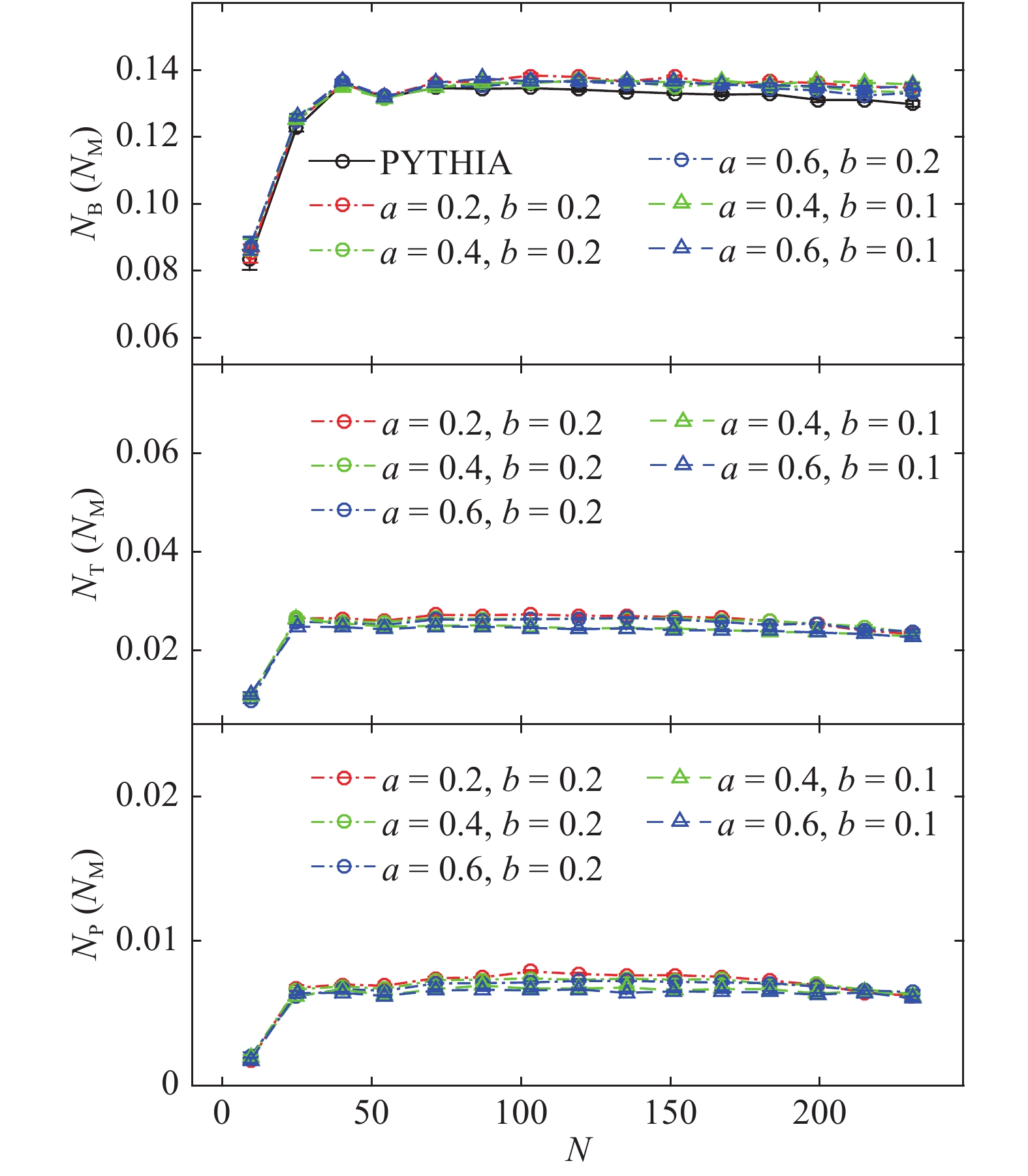 Figure3. (color online) Multiplicity dependence of baryon-to-meson (top panel), tetraquark-to-meson (middle panel) and pentaquark-to-meson (bottom panel) ratios in NSD pp collisions at
Figure3. (color online) Multiplicity dependence of baryon-to-meson (top panel), tetraquark-to-meson (middle panel) and pentaquark-to-meson (bottom panel) ratios in NSD pp collisions at As shown in Fig. 2, the ratios of baryon-to-meson, tetraquark-to-meson and pentaquark-to-meson vary as functions of the total multiplicities for different combinations of
Figure 3 presents the same ratios as in Fig. 2 but for different combinations of interaction coefficients a and b, while
2
4.2.Transverse momentum distributions
Figure 4 and Fig. 5 show the dependence of transverse momentum distributions for different values of parameters in the mid-pseudorapidity region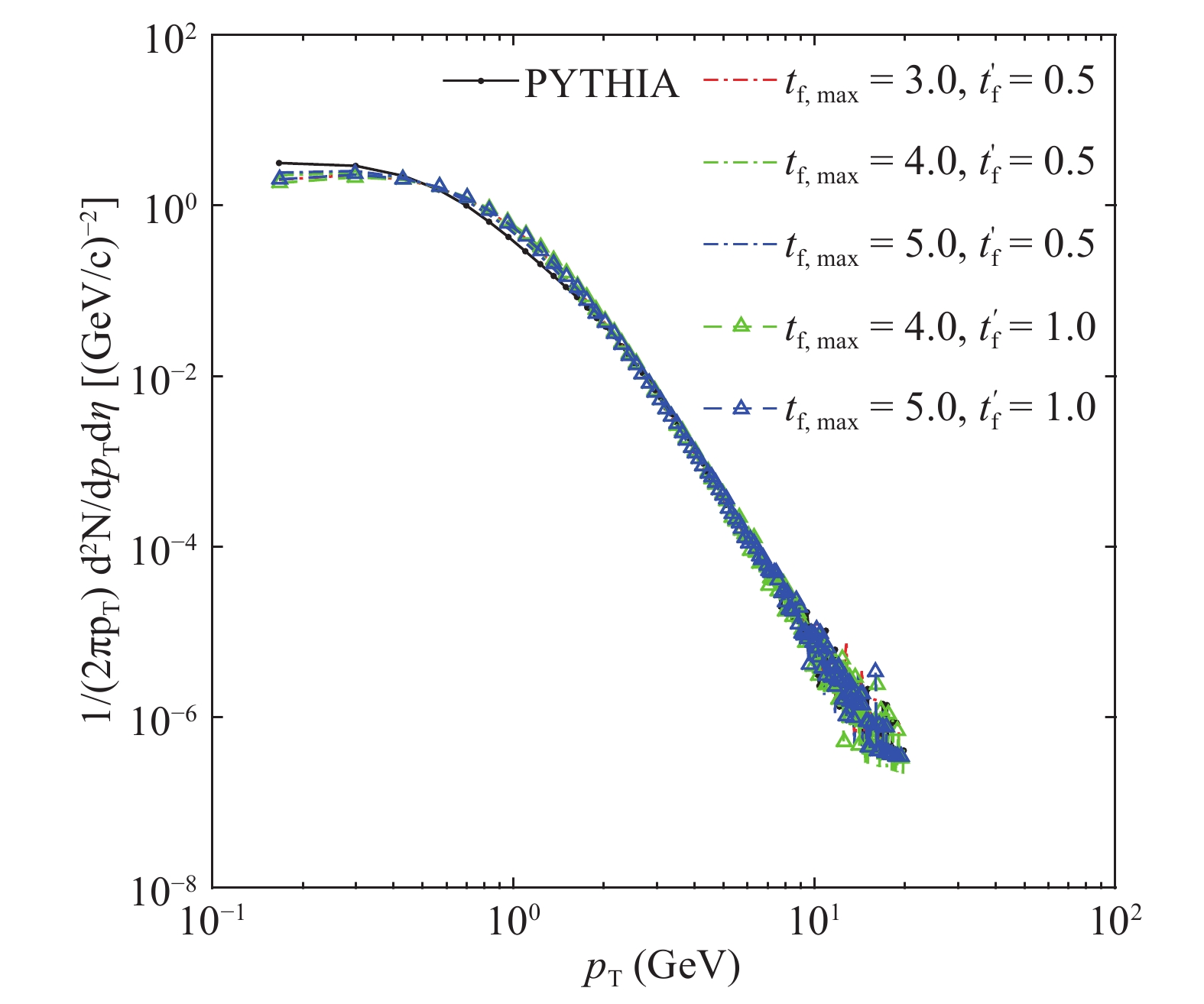 Figure4. (color online) Transverse momentum distribution in the
Figure4. (color online) Transverse momentum distribution in the 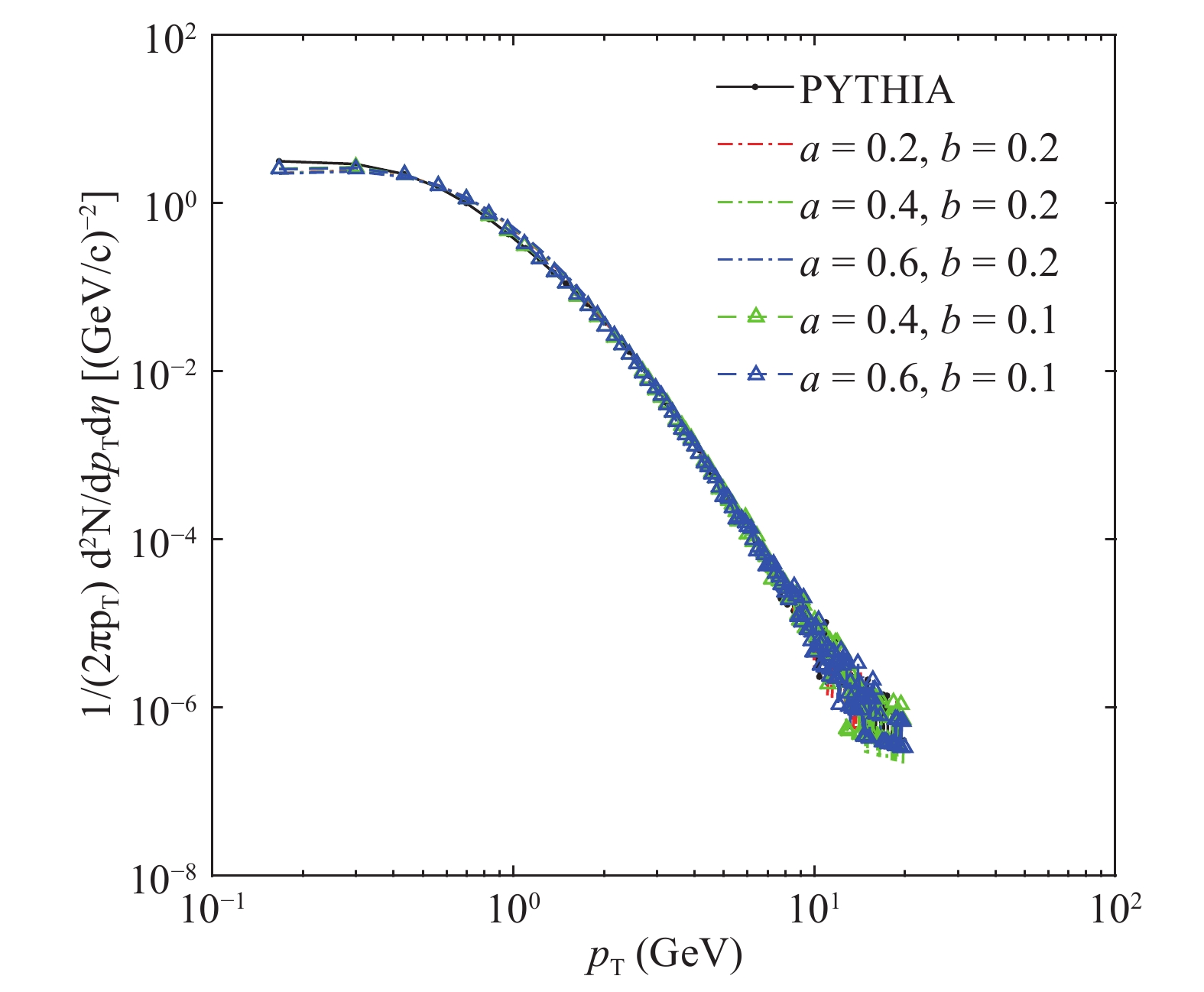 Figure5. (color online) Transverse momentum distribution in the
Figure5. (color online) Transverse momentum distribution in the Figure 4 presents the dependence of the transverse momentum distribution for different combinations of maximum value of formation time
The influence of different values of a and b is shown in Fig. 5. The difference between the distributions from PYTHIA and our model increases with the increase of b, while it changes little with the variation of a. Clearly b has a larger effect on the distributions, since it determines the strength of short range interaction in Eq. (1), which is much stronger than the linear part when the quarks are close to each other. This indicates that the deviation is mainly formed in the early stage of system evolution, when the quarks in the system are compact, and the Coulomb potential, as a short range interaction, is of great influence.
2
4.3.Pseudorapidity distributions
Figure 6 and Fig. 7 show the pseudorapidity distributions for different values of parameters. There is no restriction on the selection of transverse momentum. Figure6. (color online) Pseudorapidity distribution in NSD pp collisions at
Figure6. (color online) Pseudorapidity distribution in NSD pp collisions at  Figure7. (color online) Pseudorapidity distribution in NSD pp collisions at
Figure7. (color online) Pseudorapidity distribution in NSD pp collisions at As is shown in Fig. 6, with fixed a and b, the pseudorapidity distributions are evidently different from the ones obtained with PYTHIA. The distributions in the pseudorapidity region
From Fig. 7, one can see that for fixed
Figure 8 and Fig. 9 show the pseudorapidity distributions of tetraquarks and pentaquarks for different combinations of parameters. One can see from these figures that the multi-quark states are mainly distributed in the very forward-backward pseudorapidity region. This can be understood from the fact that quarks in the very forward-backward pseudorapidity region have often large momenta, so that they easily stick together if they happen to be close to each other at the beginning of the evolution, and thus have a larger probability to form multi-quark states.
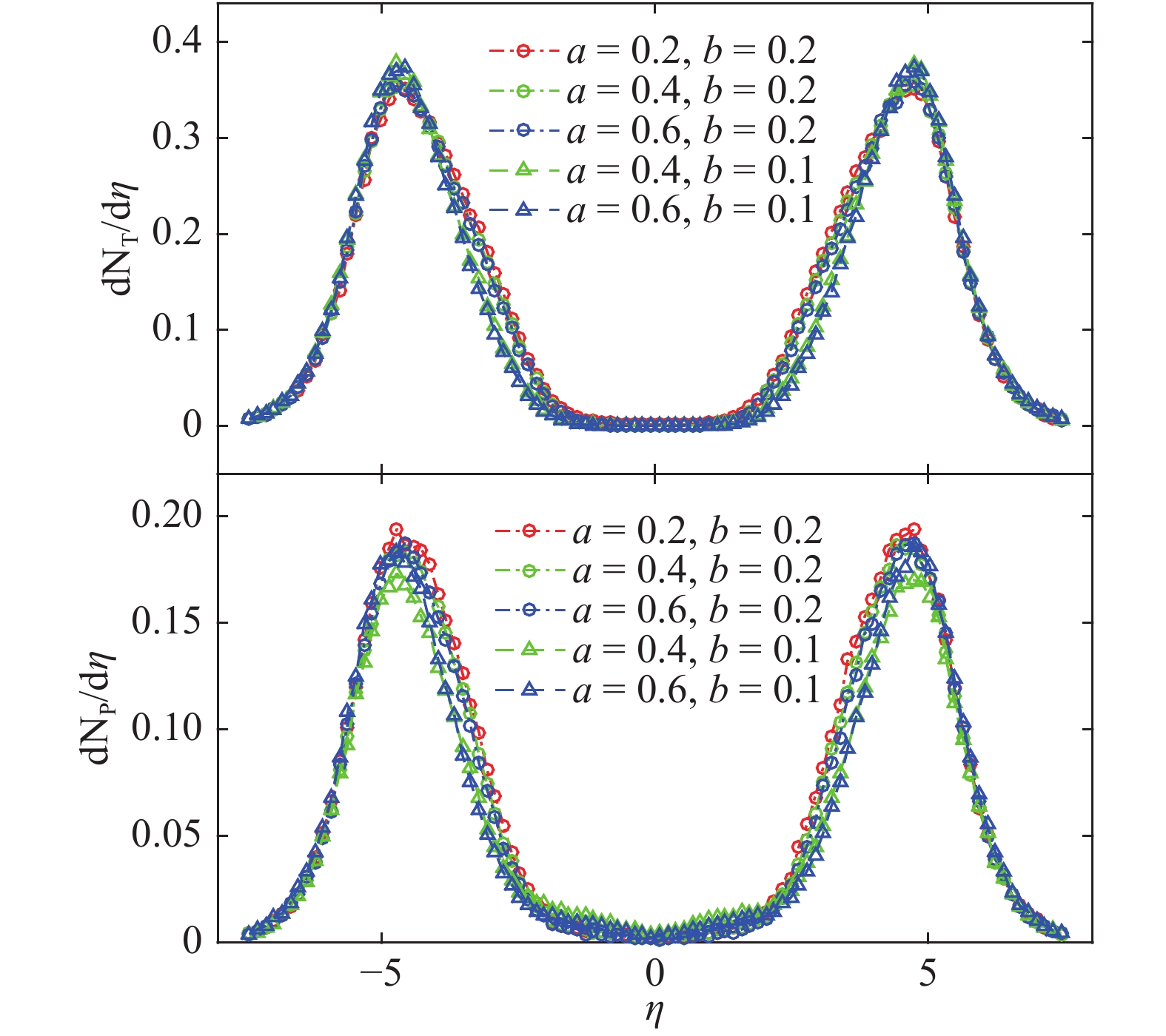 Figure9. (color online) Pseudorapidity distribution of tetraquarks (top panel) and pentaquarks (bottom panel) in NSD pp collisions at
Figure9. (color online) Pseudorapidity distribution of tetraquarks (top panel) and pentaquarks (bottom panel) in NSD pp collisions at  Figure8. (color online) Pseudorapidity distribution of tetraquarks (top panel) and pentaquarks (bottom panel) in NSD pp collisions at
Figure8. (color online) Pseudorapidity distribution of tetraquarks (top panel) and pentaquarks (bottom panel) in NSD pp collisions at 2
4.4.Forward-backward multiplicity correlations
Correlations and fluctuations are important tools for studying the mechanism of particle production in high energy collisions. The correlations and fluctuations of produced particles may change significantly in a phase transition because of the change of degrees of freedom. Forward-backward multiplicity correlations have been studied widely to analyze the mechanism of particle production [47, 48] , and they played an important role in the development of mechanisms of multi-parton interactions in the PYTHIA model [49]. The forward-backward multiplicity correlations are usually defined as correlation coefficients of forward and backward multiplicities${b_{\rm corr}} = \frac{{\langle {n_F}{n_B}\rangle - \langle {n_F}\rangle \langle {n_B}\rangle }}{{\sqrt {(\langle n_F^2\rangle - {{\langle {n_F}\rangle }^2})(\langle n_B^2\rangle - {{\langle {n_B}\rangle }^2})} }},$ | (16) |
${b_{\rm corr}} = \frac{{\langle {n_F}{n_B}\rangle - {{\langle {n_F}\rangle }^2}}}{{\langle n_F^2\rangle - {{\langle {n_F}\rangle }^2}}}.$ | (17) |
 Figure11. (color online) Forward-backward correlations in NSD pp collisions at
Figure11. (color online) Forward-backward correlations in NSD pp collisions at 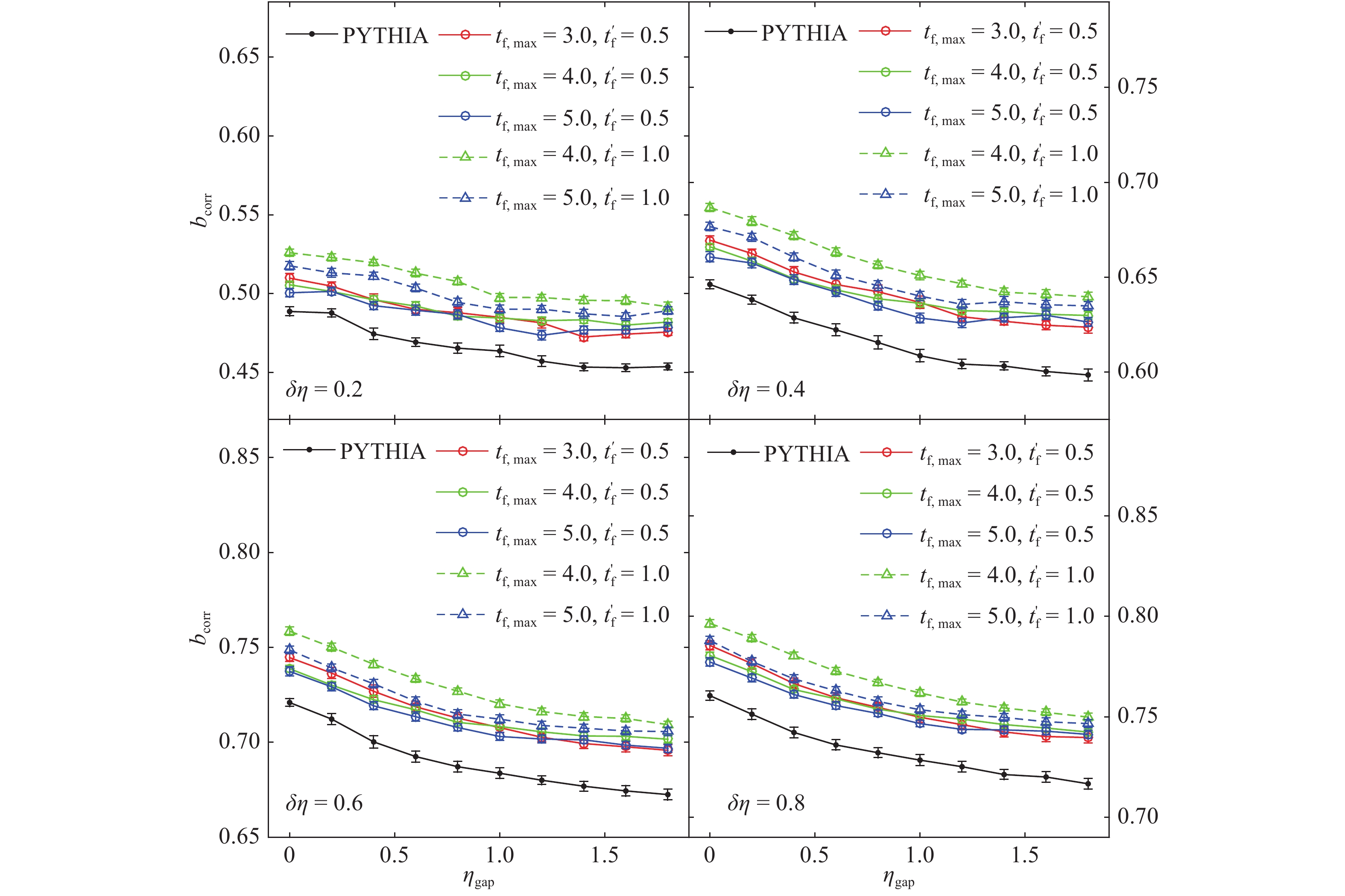 Figure10. (color online) Forward-backward correlations in NSD pp collisions at
Figure10. (color online) Forward-backward correlations in NSD pp collisions at Figure 10 presents the dependence of forward-backward correlations as function of
The dependence of the correlations on parameters a and b is presented in Fig. 11. The increase of b leads to an increase of correlations, whereas the change of a has little effect, which indicates that the contribution to correlations is mainly from the initial interactions, when the partons are close and the Coulomb term in Eq. (1) plays a major role in the evolution process.
The present work could be improved in several aspects:
(1) The initial space positions of hadrons and quarks should stem from a more solid basis;
(2) The form of interaction should include more realistic physical effects, such as Debye screening etc.;
(3) Relativistic retarding effect could also be considered. All of these will be considered in a future work.
